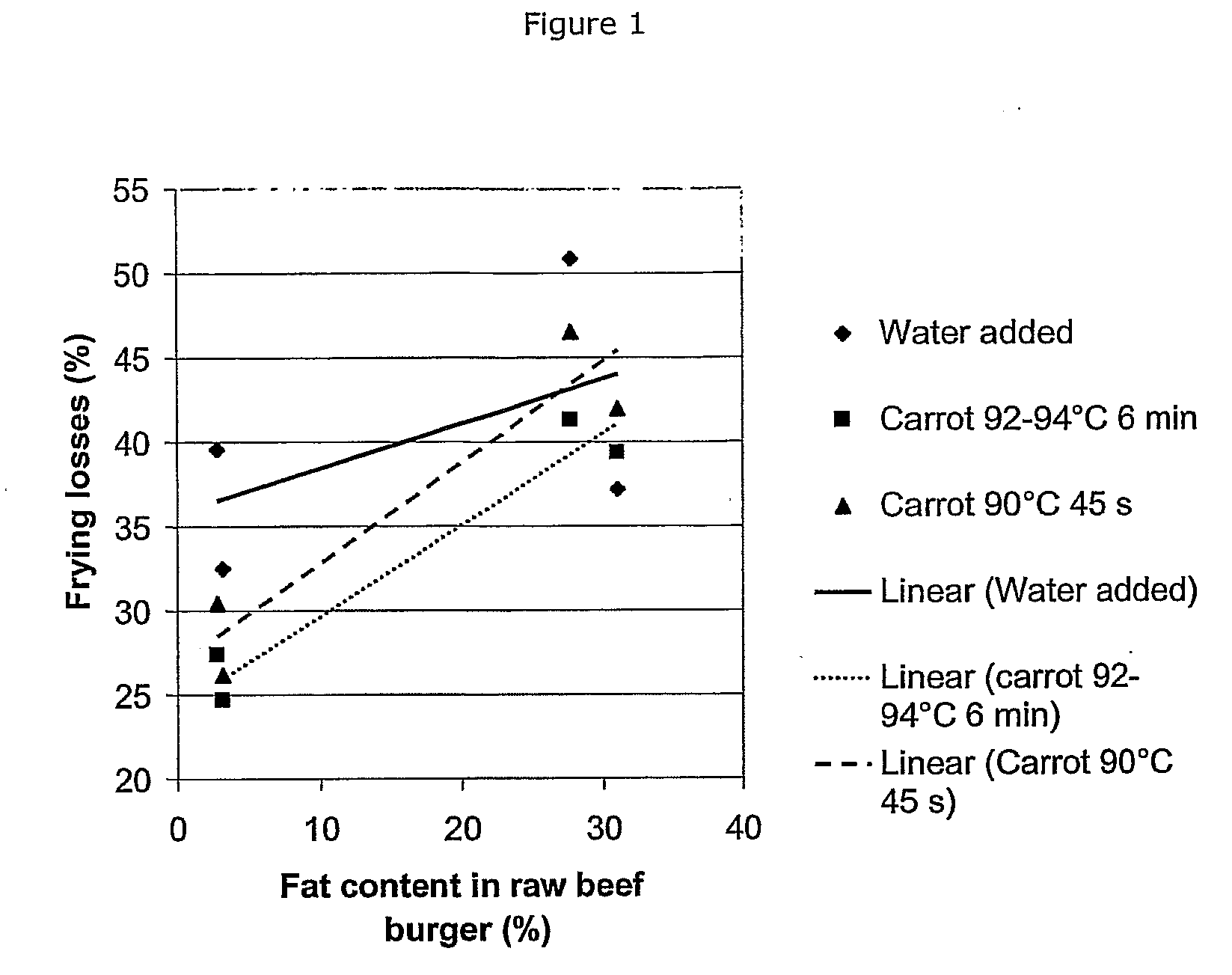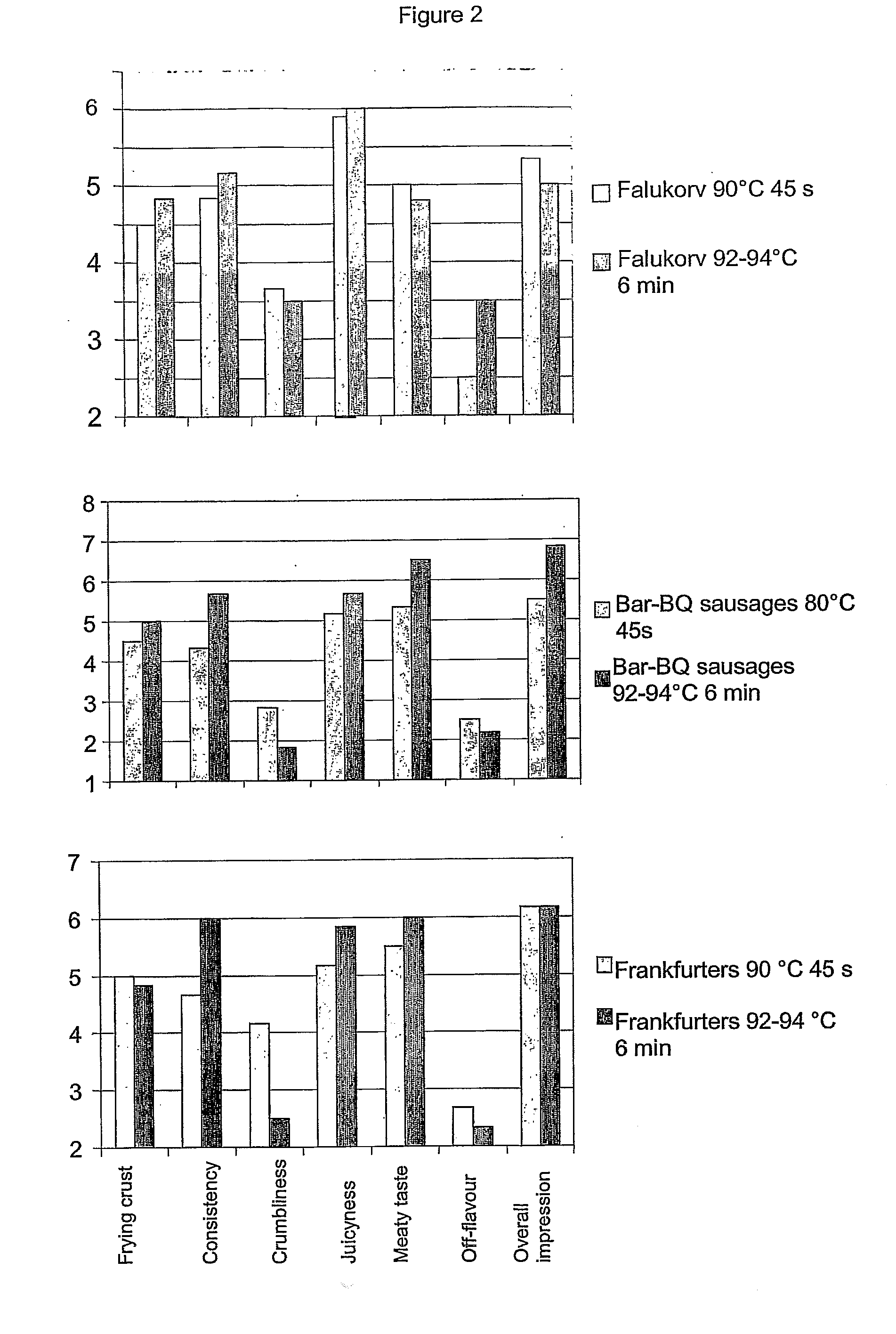Vegetable fat replacement in meat products
a technology of vegetable fat and meat products, applied in the field of vegetable fat replacement in meat products, can solve the problems of increasing the risk of obesity, reducing the fat in meat products, and presenting a number of difficulties in appearance, flavor and texture, so as to enhance the interaction with the meat system, improve the activity of pme, and modify the esterification characteristics of pectin
- Summary
- Abstract
- Description
- Claims
- Application Information
AI Technical Summary
Benefits of technology
Problems solved by technology
Method used
Image
Examples
example 1
The Influence of Purified HM- LM- and Ca 2+LM Pectins In a Model Emulsion Sausage Batter
[0038] This example demonstrates the interaction between pectin and the myosin network in a model emulsion sausage batter. Fresh boneless pork cutlet is trimmed to provide very lean meat. The lean meat was ground through a 12 mm plate, and then through a 3 mm plate in a meat mincer. The protein, water and fat contents are respectively 20%, 80% and 0%. Three different W / P ratios were investigated; W / P 5, 6.5 and 8.
[0039] Pectins were provided by Danisco Copenhagen. Two different types of pectins were used: LM pectin with a degree of esterification of 34% (G pectin LC1900) and HM pectin with a DE of 68% (G pectin 1400) determined by total acidity titration. Pectin solution / gels were produced by dilution of an appropriate amount of pectin powder in hot nearly boiling water under high speed magnetic stirring and let to solubilize for 2 hours until no visible particles could be seen. Appropriate am...
example 2
The Preparation of Meat Products Comprising Carrot Fibers Treated to Control PME Activity
[0041] The following example demonstrates a pre-treatment process for the carrot raw material to obtain pectin within the vegetable fiber for use in emulsion sausages. Raw carrots are cleaned in tap water, sliced in 10 mm thick slices. The slices undergo blanching with a volume loading ratio of 1 part carrot in 4 parts of water. The blanching times and temperatures were the following: 15 min at 40° C., 25 min at 40° C., 15 min at 60° C. Aid 25 min at 60° C. Raw carrots were used as a control for comparison throughout the procedure.
[0042] The water content of the carrots increase with increasing blanching time and temperature, giving a swelling of the carrots, indicating that the cell walls are destabilized due to the action of PME or the action of heat on heat labile bonds between pectin molecules in the cell wall. The deesterification of pectin in treated carrots can be followed in either of...
example 3
An Optimized Preparation of Meat Products Comprising Carrot Fibers Treated to Control PME Activity
[0047] From examples 1 and 2 it can be concluded that the higher the degree of pectin esterification, the better the vegetable fiber fits with the meat system. In example 2, the high degree of pectin esterification, was obtained at the lowest temperature (40° C.) Aid the shortest times (15 min) when the activity of the PME was the lowest. Another possible way to lower the PEM activity in order to obtain HM pectins is to use heat treatments at much higher temperatures for shorter times. Carrot cubes (10*10*10 mm) were heat treated at 92-94° C. for 6 minutes and 45 s.
[0048] The following procedure demonstrates the optimized pre-treatment process for the carrot raw material to obtain the most favorable esterified pectin and maximal swelling for the vegetable fibers for use in meat products. Raw carrots are cleaned in tap water, diced in 10×10×10 mm cubes. The blanching times and tempera...
PUM
 Login to View More
Login to View More Abstract
Description
Claims
Application Information
 Login to View More
Login to View More - R&D
- Intellectual Property
- Life Sciences
- Materials
- Tech Scout
- Unparalleled Data Quality
- Higher Quality Content
- 60% Fewer Hallucinations
Browse by: Latest US Patents, China's latest patents, Technical Efficacy Thesaurus, Application Domain, Technology Topic, Popular Technical Reports.
© 2025 PatSnap. All rights reserved.Legal|Privacy policy|Modern Slavery Act Transparency Statement|Sitemap|About US| Contact US: help@patsnap.com



